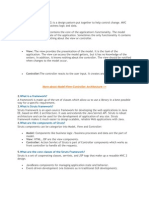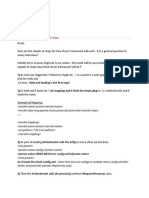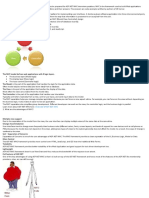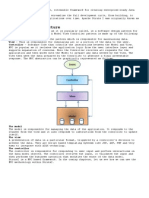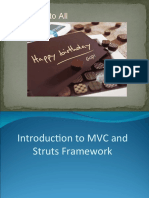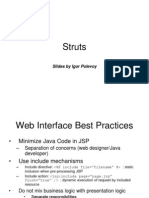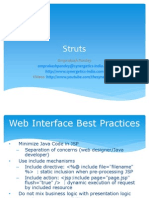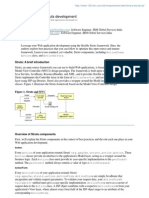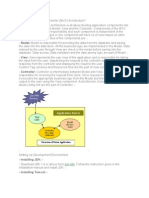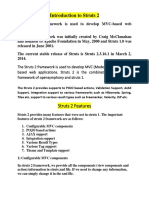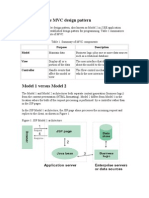0 ratings0% found this document useful (0 votes)
54 viewsStruts Interview Questions 40
Struts Interview Questions 40
Uploaded by
Abhi Roy OviThe document provides details about Struts interview questions and answers. It discusses key concepts in Struts like MVC architecture, components of Struts framework including ActionServlet, ActionForm, Action class etc. It describes various design patterns used in Struts and different types of actions like ForwardAction, IncludeAction, DispatchAction etc. The document also covers directory structure of Struts application and differences between various configuration related concepts.
Copyright:
Attribution Non-Commercial (BY-NC)
Available Formats
Download as PDF, TXT or read online from Scribd
Struts Interview Questions 40
Struts Interview Questions 40
Uploaded by
Abhi Roy Ovi0 ratings0% found this document useful (0 votes)
54 views10 pagesThe document provides details about Struts interview questions and answers. It discusses key concepts in Struts like MVC architecture, components of Struts framework including ActionServlet, ActionForm, Action class etc. It describes various design patterns used in Struts and different types of actions like ForwardAction, IncludeAction, DispatchAction etc. The document also covers directory structure of Struts application and differences between various configuration related concepts.
Original Description:
Struts
Copyright
© Attribution Non-Commercial (BY-NC)
Available Formats
PDF, TXT or read online from Scribd
Share this document
Did you find this document useful?
Is this content inappropriate?
The document provides details about Struts interview questions and answers. It discusses key concepts in Struts like MVC architecture, components of Struts framework including ActionServlet, ActionForm, Action class etc. It describes various design patterns used in Struts and different types of actions like ForwardAction, IncludeAction, DispatchAction etc. The document also covers directory structure of Struts application and differences between various configuration related concepts.
Copyright:
Attribution Non-Commercial (BY-NC)
Available Formats
Download as PDF, TXT or read online from Scribd
Download as pdf or txt
0 ratings0% found this document useful (0 votes)
54 views10 pagesStruts Interview Questions 40
Struts Interview Questions 40
Uploaded by
Abhi Roy OviThe document provides details about Struts interview questions and answers. It discusses key concepts in Struts like MVC architecture, components of Struts framework including ActionServlet, ActionForm, Action class etc. It describes various design patterns used in Struts and different types of actions like ForwardAction, IncludeAction, DispatchAction etc. The document also covers directory structure of Struts application and differences between various configuration related concepts.
Copyright:
Attribution Non-Commercial (BY-NC)
Available Formats
Download as PDF, TXT or read online from Scribd
Download as pdf or txt
You are on page 1of 10
Mohammad Makhanawala Page 1
Struts interview questions
1.What is MVC?
Model-View-Controller (MVC) is a design pattern put together to help control change. MVC decouples interface from business logic and
data.
Model : The model contains the core of the application's functionality. The model encapsulates the state of the application.
Sometimes the only functionality it contains is state. It knows nothing about the view or controller.
View: The view provides the presentation of the model. It is the look of the application. The view can access the model
getters, but it has no knowledge of the setters. In addition, it knows nothing about the controller. The view should be notified
when changes to the model occur.
Controller:The controller reacts to the user input. It creates and sets the model.
2.What is a framework?
A framework is made up of the set of classes which allow us to use a library in a best possible way for a specific requirement.
3.What is Struts framework?
Struts framework is an open-source framework for developing the web applications in Java EE, based on MVC-2 architecture. It uses and
extends the Java Servlet API. Struts is robust architecture and can be used for the development of application of any size. Struts
framework makes it much easier to design scalable, reliable Web applications with Java.
4.What are the components of Struts?
Struts components can be categorize into Model, View and Controller:
Model: Components like business logic /business processes and data are the part of model.
View: HTML, JSP are the view components.
Controller: Action Servlet of Struts is part of Controller components which works as front controller to handle all the requests.
5.What are the core classes of the Struts Framework?
Struts is a set of cooperating classes, servlets, and JSP tags that make up a reusable MVC 2 design.
JavaBeans components for managing application state and behavior.
Event-driven development (via listeners as in traditional GUI development).
Pages that represent MVC-style views; pages reference view roots via the JSF component tree.
6.What is ActionServlet?
ActionServlet is a simple servlet which is the backbone of all Struts applications. It is the main Controller component that handles client
requests and determines which Action will process each received request. It serves as an Action factory creating specific Action classes
based on users request.
7.What is role of ActionServlet?
ActionServlet performs the role of Controller:
Process user requests
Determine what the user is trying to achieve according to the request
Pull data from the model (if necessary) to be given to the appropriate view,
Select the proper view to respond to the user
Delegates most of this grunt work to Action classes
Is responsible for initialization and clean-up of resources
8.What is the ActionForm?
ActionForm is javabean which represents the form inputs containing the request parameters from the View referencing the Action bean.
9.What are the important methods of ActionForm?
The important methods of ActionForm are : validate() & reset().
10.Describe validate() and reset() methods ?
validate() : Used to validate properties after they have been populated; Called before FormBean is handed to Action. Returns a
collection of ActionError as ActionErrors. Following is the method signature for the validate() method.
Mohammad Makhanawala Page 2
public ActionErrors validate(ActionMapping
mapping,HttpServletRequest request)
reset(): reset() method is called by Struts Framework with each request that uses the defined ActionForm. The purpose of this method
is to reset all of the ActionForm's data members prior to the new request values being set.
public void reset() {}
11.What is ActionMapping?
Action mapping contains all the deployment information for a particular Action bean. This class is to determine where the results of the
Action will be sent once its processing is complete.
12.How is the Action Mapping specified ?
We can specify the action mapping in the configuration file called struts-config.xml. Struts framework creates ActionMappingobject
from <ActionMapping> configuration element of struts-config.xml file
<action-mappings>
<action path="/submit"
type="submit.SubmitAction"
name="submitForm"
input="/submit.jsp"
scope="request"
validate="true">
<forward name="success" path="/success.jsp"/>
<forward name="failure" path="/error.jsp"/>
</action>
</action-mappings>
13.What is role of Action Class?
An Action Class performs a role of an adapter between the contents of an incoming HTTP request and the corresponding business logic
that should be executed to process this request.
14.In which method of Action class the business logic is executed ?
In the execute() method of Action class the business logic is executed.
Mohammad Makhanawala Page 3
public ActionForward execute(
ActionMapping mapping,
ActionForm form,
HttpServletRequest request,
HttpServletResponse response)
throws Exception ;
execute() method of Action class:
Perform the processing required to deal with this request
Update the server-side objects (Scope variables) that will be used to create the next page of the user interface
Return an appropriate ActionForward object
15.What design patterns are used in Struts?
Struts is based on model 2 MVC (Model-View-Controller) architecture. Struts controller uses the command design pattern and the action
classes use the adapter design pattern. The process() method of the RequestProcessor uses the template method design pattern.
Struts also implement the following J2EE design patterns.
Service to Worker
Dispatcher View
Composite View (Struts Tiles)
Front Controller
View Helper
Synchronizer Token
16.Can we have more than one struts-config.xml file for a single Struts application?
Yes, we can have more than one struts-config.xml for a single Struts application. They can be configured as follows:
<servlet>
<servlet-name>action</servlet-name>
<servlet-class>
org.apache.struts.action.ActionServlet
</servlet-class>
<init-param>
<param-name>config</param-name>
<param-value>
/WEB-INF/struts-config.xml,
/WEB-INF/struts-admin.xml,
Mohammad Makhanawala Page 4
/WEB-INF/struts-config-forms.xml
</param-value>
</init-param>
.....
<servlet>
17.What is the directory structure of Struts application?
The directory structure of Struts application :
18.What is the difference between session scope and request scope when saving formbean ?
when the scope is request,the values of formbean would be available for the current request.
when the scope is session,the values of formbean would be available throughout the session.
19.What are the important tags of struts-config.xml ?
The five important sections are:
Mohammad Makhanawala Page 5
20.What are the different kinds of actions in Struts?
The different kinds of actions in Struts are:
ForwardAction
IncludeAction
DispatchAction
LookupDispatchAction
SwitchAction
21.What is DispatchAction?
The DispatchAction class is used to group related actions into one class. Using this class, you can have a method for each logical action
compared than a single execute method. The DispatchAction dispatches to one of the logical actions represented by the methods. It picks
Mohammad Makhanawala Page 6
a method to invoke based on an incoming request parameter. The value of the incoming parameter is the name of the method that the
DispatchAction will invoke.
22.How to use DispatchAction?
To use the DispatchAction, follow these steps :
Create a class that extends DispatchAction (instead of Action)
In a new class, add a method for every function you need to perform on the service The method has the same signature as
the execute() method of an Action class.
Do not override execute() method Because DispatchAction class itself provides execute() method.
Add an entry to struts-config.xml
DispatchAction Example
23.What is the use of ForwardAction?
The ForwardAction class is useful when youre trying to integrate Struts into an existing application that uses Servlets to perform
business logic functions. You can use this class to take advantage of the Struts controller and its functionality, without having to rewrite
the existing Servlets. Use ForwardAction to forward a request to another resource in your application, such as a Servlet that already
does business logic processing or even another JSP page. By using this predefined action, you dont have to write your own Action class.
You just have to set up the struts-config file properly to use ForwardAction.
24.What is IncludeAction?
The IncludeAction class is useful when you want to integrate Struts into an application that uses Servlets. Use the IncludeAction class
to include another resource in the response to the request being processed.
25.What is the difference between ForwardAction and IncludeAction?
The difference is that you need to use the IncludeAction only if the action is going to be included by another action or jsp.
UseForwardAction to forward a request to another resource in your application, such as a Servlet that already does business logic
processing or even another JSP page.
26.What is LookupDispatchAction?
The LookupDispatchAction is a subclass of DispatchAction. It does a reverse lookup on the resource bundle to get the key and then
gets the method whose name is associated with the key into the Resource Bundle.
27.What is the use of LookupDispatchAction?
LookupDispatchAction is useful if the method name in the Action is not driven by its name in the front end, but by the Locale independent
key into the resource bundle. Since the key is always the same, the LookupDispatchAction shields your application from the side effects
of I18N.
28.What is difference between LookupDispatchAction and DispatchAction?
The difference between LookupDispatchAction and DispatchAction is that the actual method that gets called in LookupDispatchAction is
based on a lookup of a key value instead of specifying the method name directly.
29.What is SwitchAction?
The SwitchAction class provides a means to switch from a resource in one module to another resource in a different module. SwitchAction
is useful only if you have multiple modules in your Struts application. The SwitchAction class can be used as is, without extending.
30.What if <action> element has <forward> declaration with same name as global forward?
In this case the global forward is not used. Instead the <action> elements <forward>takes precendence.
31.What is DynaActionForm?
A specialized subclass of ActionForm that allows the creation of form beans with dynamic sets of properties (configured in configuration
file), without requiring the developer to create a Java class for each type of form bean.
Mohammad Makhanawala Page 7
32.What are the steps need to use DynaActionForm?
Using a DynaActionForm instead of a custom subclass of ActionForm is relatively straightforward. You need to make changes in two
places:
In struts-config.xml: change your <form-bean> to be an org.apache.struts.action.DynaActionForm instead of some
subclass of ActionForm
<form-bean
name="loginForm"type="org.apache.struts.action.DynaActionForm" >
<form-property name="userName" type="java.lang.String"/>
<form-property name="password" type="java.lang.String" />
</form-bean>
In your Action subclass that uses your form bean:
o import org.apache.struts.action.DynaActionForm
o downcast the ActionForm parameter in execute() to a DynaActionForm
o access the form fields with get(field) rather than getField()
import javax.servlet.http.HttpServletRequest;
import javax.servlet.http.HttpServletResponse;
import org.apache.struts.action.Action;
import org.apache.struts.action.ActionForm;
import org.apache.struts.action.ActionForward;
import org.apache.struts.action.ActionMapping;
import org.apache.struts.action.ActionMessage;
import org.apache.struts.action.ActionMessages;
import org.apache.struts.action.DynaActionForm;
public class DynaActionFormExample extends Action {
public ActionForward execute(ActionMapping mapping, ActionForm
Mohammad Makhanawala Page 8
form,
HttpServletRequest request, HttpServletResponse response)
throws Exception {
DynaActionForm loginForm = (DynaActionForm) form;
ActionMessages errors = new ActionMessages();
if (((String) loginForm.get("userName")).equals("")) {
errors.add("userName", new ActionMessage(
"error.userName.required"));
}
if (((String) loginForm.get("password")).equals("")) {
errors.add("password", new ActionMessage(
"error.password.required"));
}
...........
33.How to display validation errors on jsp page?
<html:errors/> tag displays all the errors. <html:errors/> iterates over ActionErrors request attribute.
34.What are the various Struts tag libraries?
The various Struts tag libraries are:
HTML Tags
Bean Tags
Logic Tags
Template Tags
Nested Tags
Tiles Tags
35.What is the use of <logic:iterate>?
<logic:iterate> repeats the nested body content of this tag over a specified collection.
<table border=1>
<logic:iterate id="customer" name="customers">
<tr>
<td><bean:write name="customer"
Mohammad Makhanawala Page 9
property="firstName"/></td>
<td><bean:write name="customer" property="lastName"/></td>
<td><bean:write name="customer" property="address"/></td>
</tr>
</logic:iterate>
</table>
36.What are differences between <bean:message> and <bean:write>
<bean:message>: is used to retrive keyed values from resource bundle. It also supports the ability to include parameters that can be
substituted for defined placeholders in the retrieved string.
<bean:message key="prompt.customer.firstname"/>
<bean:write>: is used to retrieve and print the value of the bean property. <bean:write> has no body.
<bean:write name="customer" property="firstName"/>
37.How the exceptions are handled in struts?
Exceptions in Struts are handled in two ways:
Programmatic exception handling :
Explicit try/catch blocks in any code that can throw exception. It works well when custom value (i.e., of variable) needed
when error occurs.
Declarative exception handling :You can either define <global-exceptions> handling tags in your struts-config.xml or
define the exception handling tags within <action></action> tag. It works well when custom page needed when error
occurs. This approach applies only to exceptions thrown by Actions.
<global-exceptions>
<exception key="some.key"
type="java.lang.NullPointerException"
path="/WEB-INF/errors/null.jsp"/>
</global-exceptions>
or
<exception key="some.key"
type="package.SomeException"
path="/WEB-INF/somepage.jsp"/>
38.What is difference between ActionForm and DynaActionForm?
Mohammad Makhanawala Page 10
An ActionForm represents an HTML form that the user interacts with over one or more pages. You will provide properties to
hold the state of the form with getters and setters to access them. Whereas, using DynaActionForm there is no need of
providing properties to hold the state. Instead these properties and their type are declared in the struts-config.xml
The DynaActionForm bloats up the Struts config file with the xml based definition. This gets annoying as the Struts Config file
grow larger.
The DynaActionForm is not strongly typed as the ActionForm. This means there is no compile time checking for the form
fields. Detecting them at runtime is painful and makes you go through redeployment.
ActionForm can be cleanly organized in packages as against the flat organization in the Struts Config file.
ActionForm were designed to act as a Firewall between HTTP and the Action classes, i.e. isolate and encapsulate the HTTP
request parameters from direct use in Actions. With DynaActionForm, the property access is no different than using
request.getParameter( .. ).
DynaActionForm construction at runtime requires a lot of Java Reflection (Introspection) machinery that can be
avoided.
39.How can we make message resources definitions file available to the Struts framework environment?
We can make message resources definitions file (properties file) available to Struts framework environment by adding this file to struts-
config.xml.
<message-resources
parameter="com.login.struts.ApplicationResources"/>
40.What is the life cycle of ActionForm?
The lifecycle of ActionForm invoked by the RequestProcessor is as follows:
Retrieve or Create Form Bean associated with Action
"Store" FormBean in appropriate scope (request or session)
Reset the properties of the FormBean
Populate the properties of the FormBean
Validate the properties of the FormBean
Pass FormBean to Action
You might also like
- PPTDocument29 pagesPPTSubrat Kumar BeheraNo ratings yet
- Struts Interview QuestionsDocument10 pagesStruts Interview QuestionsGopinathNo ratings yet
- More About Model-View-Controller Architecture : Struts1.1Document64 pagesMore About Model-View-Controller Architecture : Struts1.1narasimha_test6830No ratings yet
- Mr. Jubedi Struts Interview Questions - 1: 1. What Is MVC?Document10 pagesMr. Jubedi Struts Interview Questions - 1: 1. What Is MVC?Ramanujam KondapallyNo ratings yet
- Struts InterviewDocument11 pagesStruts InterviewPritish KapaliNo ratings yet
- More About Model-View-Controller Architecture : What Is MVC?Document16 pagesMore About Model-View-Controller Architecture : What Is MVC?Annie BlossomNo ratings yet
- Struts. NoteDocument12 pagesStruts. NoteRamesh RathodNo ratings yet
- Truts Framework Questions Part 1 What Is Struts Framework?Document14 pagesTruts Framework Questions Part 1 What Is Struts Framework?Satish BabuNo ratings yet
- Struts QuestionsDocument8 pagesStruts QuestionssruthianithaNo ratings yet
- Struts Short Notes 1Document26 pagesStruts Short Notes 1Ashwin AjmeraNo ratings yet
- Interviw QuestionsDocument13 pagesInterviw QuestionsAshok KumarNo ratings yet
- What Is Struts Framework?: Actionerrors Validate (Actionmapping, Httpservletrequest)Document7 pagesWhat Is Struts Framework?: Actionerrors Validate (Actionmapping, Httpservletrequest)Saurit KarNo ratings yet
- Most Asked ASP - Net MVC Interview Questions and Answers C Sharp CornerDocument39 pagesMost Asked ASP - Net MVC Interview Questions and Answers C Sharp CornerLokesh RavindraNo ratings yet
- What Is Model-View-Controller (MVC) Architecture?Document8 pagesWhat Is Model-View-Controller (MVC) Architecture?Aman GhotraNo ratings yet
- An Introduction To Struts 1Document12 pagesAn Introduction To Struts 1wkdjhdjhwdNo ratings yet
- Core MVCDocument135 pagesCore MVCR.A. AruneashNo ratings yet
- Answers: AnswerDocument79 pagesAnswers: AnswerShaik Mohammad HaneefNo ratings yet
- Understanding Struts Controller: Definition: A Framework Is A Collection ofDocument22 pagesUnderstanding Struts Controller: Definition: A Framework Is A Collection ofpinky548No ratings yet
- MVC QuestionDocument50 pagesMVC QuestionShariq AliNo ratings yet
- 1rgMVC IQDocument39 pages1rgMVC IQRang GoudNo ratings yet
- Struts 1Document23 pagesStruts 1bhardwaj_chandanNo ratings yet
- StructsDocument29 pagesStructsImreena AliNo ratings yet
- What Is The Difference Between Bean Factory and Application Context ?Document7 pagesWhat Is The Difference Between Bean Factory and Application Context ?RavikumarmaddiNo ratings yet
- Java Full Stack Interview QuestionsDocument5 pagesJava Full Stack Interview QuestionsNaveen AlluriNo ratings yet
- StrutsDocument43 pagesStrutsvedicsoft100% (4)
- In This Session - We'll Look OnDocument11 pagesIn This Session - We'll Look Onsourabhkarn6262No ratings yet
- Struts 2Document4 pagesStruts 2nizax91No ratings yet
- Itut 45654Document35 pagesItut 45654api-3694132No ratings yet
- Struts 1Document31 pagesStruts 1Mohammed JeelanNo ratings yet
- Welcome To All: Gop IDocument34 pagesWelcome To All: Gop Iarya_accentNo ratings yet
- 5) What Is The Proxy Server? ANSWER: A Proxy Server Speaks The Client Side of A Protocol To Another ServerDocument157 pages5) What Is The Proxy Server? ANSWER: A Proxy Server Speaks The Client Side of A Protocol To Another Serveraakarsha91No ratings yet
- MVC & Struts NotesDocument6 pagesMVC & Struts NotesMukesh100% (1)
- More About Model-View-Controller Architecture : Struts Interview QuestionsDocument7 pagesMore About Model-View-Controller Architecture : Struts Interview QuestionssurendargrNo ratings yet
- Struts 2 Best PracticeDocument48 pagesStruts 2 Best PracticePratik ShahNo ratings yet
- Struts 2.0: by Omprakash Pandey SynergeticsDocument50 pagesStruts 2.0: by Omprakash Pandey SynergeticsNguyễn Tuấn AnhNo ratings yet
- StrutsDocument87 pagesStrutssensationalsrinuNo ratings yet
- MVC Interview Questions and AnswersDocument19 pagesMVC Interview Questions and AnswersAfra Fathima100% (1)
- Jakarta Struts QuestionsDocument14 pagesJakarta Struts Questionsapi-3748960No ratings yet
- Struts: Omprakash PandeyDocument89 pagesStruts: Omprakash Pandeyjeffa123No ratings yet
- MVC Interview Questions PDFDocument9 pagesMVC Interview Questions PDFRAJINo ratings yet
- Struts2 0documentDocument26 pagesStruts2 0documentJava DeveloperNo ratings yet
- Tutorial - Best Practices For Struts DevelopmentDocument6 pagesTutorial - Best Practices For Struts Developmentapi-3725627No ratings yet
- Serv LetDocument56 pagesServ LetAmar PatelNo ratings yet
- Installing JDK: - : Sun SiteDocument21 pagesInstalling JDK: - : Sun Sitenagothi_raghavendraNo ratings yet
- Airline Reservation System: Richa Singh 0812210091Document32 pagesAirline Reservation System: Richa Singh 0812210091Sapna GuptaNo ratings yet
- Struts Architecture Control Flow and Validation FrameworkDocument21 pagesStruts Architecture Control Flow and Validation FrameworkDhruv KakkarNo ratings yet
- Struts: Basic MVC ArchitectureDocument9 pagesStruts: Basic MVC ArchitectureKhushboo TNo ratings yet
- Question Bank-Part A (2 Marks) - Unit II Struts and HibernateDocument25 pagesQuestion Bank-Part A (2 Marks) - Unit II Struts and Hibernatearavindan476No ratings yet
- Introduction To StrutsDocument17 pagesIntroduction To StrutsRavi Gaurav PandeyNo ratings yet
- Basic MVC Interview QuestionsDocument5 pagesBasic MVC Interview Questionssatishpawar123No ratings yet
- MVC 3Document14 pagesMVC 3Silent SeekerNo ratings yet
- Framework: Limitations of Developing Web-Application Using JSP/ServletsDocument9 pagesFramework: Limitations of Developing Web-Application Using JSP/ServletsMayuri ShahNo ratings yet
- Unit02 Struts NotesDocument14 pagesUnit02 Struts NotesGagandeep MarwahNo ratings yet
- Explain MVC (Model-View-Controller) in General?Document195 pagesExplain MVC (Model-View-Controller) in General?nayab.mca2008No ratings yet
- Paper 2 - Websites Based On J2EE of StrutsDocument6 pagesPaper 2 - Websites Based On J2EE of Strutsjosehp vNo ratings yet
- Overview of The MVC Design PatternDocument5 pagesOverview of The MVC Design PatternrajkulNo ratings yet
- MVC Interview Questions AnswersDocument12 pagesMVC Interview Questions AnswersKapil SharmaNo ratings yet
- Introduction To Jakarta Struts Objectives: If (Math - Random Nice Day!")Document5 pagesIntroduction To Jakarta Struts Objectives: If (Math - Random Nice Day!")Jorge RosalesNo ratings yet
- MVC Intv Quest - CollectionDocument22 pagesMVC Intv Quest - Collectionnitu_mca2006No ratings yet






